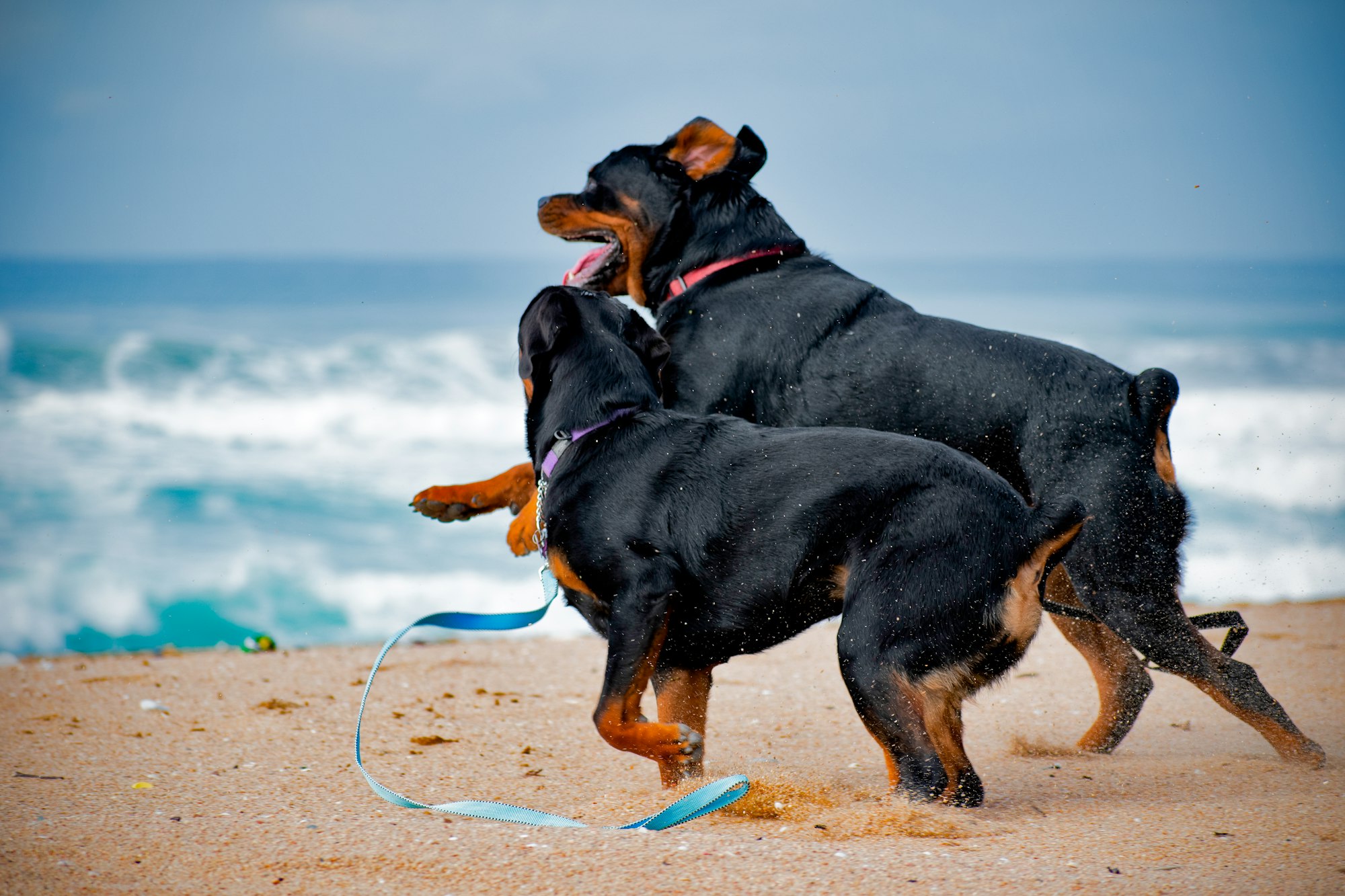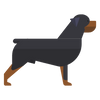Understanding Your Rottweiler's Heat Cycle

As a Rottweiler owner, understanding your Rottweiler's heat cycle is crucial. This knowledge will help you provide the best care for your pet during this period and make informed decisions about breeding. In this article, you will learn everything you need to know about the cycle.
A Rottweiler's heat is broken into four phases, lasting 6-12 months. Proestrus involves vulva swelling and bloody dishcharge. Straw-colored dishcarge and vulva wrinkling signal the Estrus phase, or the fertile period. The final phases are Diestrus and Anestrus, where reproduction is not possible.
Understanding each phase of the heat cycle can help you provide the best care for your Rottweiler. You will find ways to care for your Rottie suring this period, as well as signs she might be pregnant.
What is a Rottweiler's Heat Cycle?
The heat cycle, also known as the estrus cycle, is a period when a female Rottweiler is ready to breed. The term "estrus" means 'frenzy' and is used to describe the time in the cycle when the female is fertile (or 'in heat').
A female Rottweiler will generally enter her first estrus cycle when she is around 18 months to two years old. However, this can vary, and some may enter their first cycle earlier.
An average cycle can last between six months to one year. However, at the start and the end of a Rottweiler’s reproductive life, her cycles can become irregular. There are four phases in the cycle:
- Proestrus (~ 9 days)
- Estrus (~ 9 days)
- Diestrus (~ 60 days)
- Anestrus (90-150 days)
Each of these phases have unique physical and behavioral characteristics, which you will find below.

Proestrus
Pro = 'before'; Estrus = 'frenzy/heat'
~9 Days (3-21 days)
The proestrus phase lasts about nine days, but this time can vary between three days to three weeks. During this phase, the pituitary gland starts to produce follicle-stimulating hormone (FSH), which stimulates the growth of follicles in the ovaries.
These follicles produce estrogen, causing your Rottweiler's vulva to swell. You will also notice a bloody mucus discharge. In regards to behavior, she might show some interest in a male but will not allow any mounting or mating.
Despite these physical changes, the female is not yet ready to mate during this stage.
Estrus
Estrus = 'frenzy/heat'
~9 Days (3-21 days)
The estrus phase is when a Rottweiler is physiologically in heat. Like the proestrus phase, this phase also ranges from three days to three weeks, averaging around nine days in length. During this phase, the level of estrogen decreases, and the level of luteinizing hormone (LH) increases.
The surge in LH triggers ovulation, which is the release of eggs from the ovaries. This is the period when your Rottweiler is ready to mate. The discharge becomes less bloody and more straw-colored and your Rottweiler's vulva will appear wrinkled.
Your Rottweiler may exibit any of the following behaviors during the estrus phase:
- Become more affectionate, anxious, or aggressive (a 'change in behavior')
- Urinate more frequently (to signal to males that she is in heat)
- Become restless and uncomfortable (due to the swelling and discharge)
- Show more interested in male dogs
- Allow a male to mount and mate with her
This is the time when your Rottweiler is most fertile, so if you do not intend to breed her, it's crucial to prevent any contact with male dogs. Keep her on a leash during walks and securely fenced when outside.
Diestrus
Di = 'two/second'; Estrus = 'frenzy/heat'
~60 Days
The diestrus phase, also known as metestrus or the luteal period, is when your Rottweiler is no longer in heat. This phase lasts approximately 60 days. During diestrus, the follicles that released the eggs transform into structures called corpora lutea, which produce progesterone.
Progesterone is the hormone that maintains pregnancy. However, the level of progesterone will remain high whether the female is pregnant or not. The vulva should look normal once again, (no longer swollen or wrinkled).
This is a period of rest for your Rottweiler, and she may seem more relaxed and less active. Continue to provide regular exercise and a balanced diet, and monitor her for any signs of discomfort or unusual behavior.
Anestrus
An = 'without'; Estrus = 'frenzy/heat'
90-150 Days
The anestrus phase is the longest phase of the estrus cycle, lasting between 90 and 150 days. During anestrus, the levels of estrogen, progesterone, FSH, and LH are all low. This allows the uterus to repair itself from the changes it underwent during the previous stages.
This is a non-reproductive phase when your Rottweiler will not show any signs of being in heat. It's a good time to schedule routine vet check-ups and any injections (such as vaccinations), as her body is not dealing with the hormonal changes associated with the heat cycle.
Caring for a Rottweiler in Heat (Proestrus and Estrus)
During this time, it's important to keep your Rottweiler comfortable and clean. She will require extra patience and love.
Managing the Discharge
Some people choose to use doggy diapers or absorbant puppy pads to manage the discharge and keep their Rottweiler's bedding clean.Additionally, you might need to protect your floors and furniture from the discharge. Lastly, regular vet check-ups are essential during this period.
Grooming
Regular gentle grooming can also help your Rottweiler feel cared for and relaxed, although it is not necessary to bathe her more than usual. If you are bathing your Rottweiler to manage odors, make sure to be gentle as the swelling can be quite uncomfortable.
Preventing Pregnancy
During heat (both proestrus and estrus), it is important to keep your Rottweiler safely secured to prevent unintentional mating. If you are taking her out for exercise, keep her on a lead at all times.
Nutrition
Your Rottweiler may require more calories during her heat cycle, especially if she is pregnant. Consult your vet for the best dietary plan during this time.
Exercise and Activity
While your Rottweiler should still receive regular exercise during her heat cycle, avoid dog parks or public areas where she could attract male dogs. Keep her on a leash during walks.
Health Risks and Complications
Potential health risks associated with the heat cycle include pyometra (a severe uterine infection) and false pregnancy. If your Rottweiler shows signs of discomfort, excessive discharge, or behavioral changes, consult your vet immediately.
Signs of Pregnancy in a Rottweiler
Whether or not you are intending to breed your Rottweiler, you should be aware of signs of pregnancy if she has not been spayed. Particularly if you have noticed a 'tie' between the male and female (being stuck together after mating).
Signs of pregnancy in include:
- Increased appetite
- Weight gain
- Changes in behavior (eg. more affectionate, clingy, more relaxed, reduced interested in male dogs)
- Changes to nipple size and color (larger and a deeper pink color)
- 'Nesting' behavior (rearranging blankets, pillows or laundry to create a safe place to birth and nurse her puppies)
If you suspect your Rottweiler is pregnant, a vet can confirm this with a physical examination or ultrasound.
Male Rottweilers and the Heat Cycle
While male Rottweilers do not have estrus cycles, they can sense when a female is in heat and may exhibit behavioral changes such as restlessness and increased marking.

